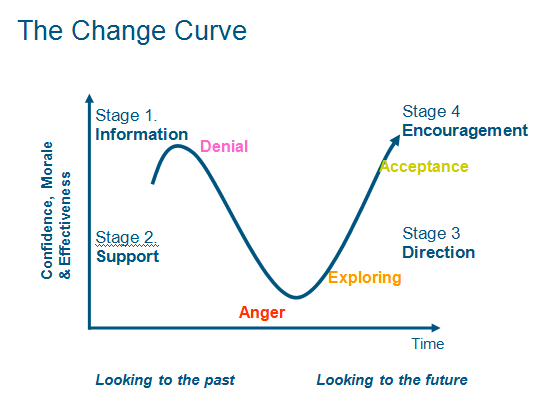Nowadays this same model is used for any crisis that we as individuals go through. Just as important, it can be used to gauge change and the effect this has on us all as individuals in organisational change management.
As with all models and ideas, it has its challengers and debaters, but nevertheless, it is a respectable tool to use to understand where people are in their journey through change.
In turn this insight can help Managers tailor approaches and effective communication to those individuals dealing with the change, helping them through the transition successfully.

Diagnose the Phases and Tailor Support
As an individual dealing with change, the length of time it takes to successfully go through this curve very much depends on that person: Some can go through quickly, others can take up to two years and more.
The challenge is to help bring people through their own change curve, by understanding which phase they are in and also what support tools they need to transition through and embrace the new change.
The General Phases of the Change Curve
Denial – The first stage: Once information has been received as to the ideals of change, this natural reaction is to deny that there is a need for change and in fact it is not happening. In a change sense, typical words that are used at this stage are, it won’t work here, we have tried it before, Why is this happening to me?
My Advice: Focus on Maximising face-to-face communication and address the “what’s in it for me” issues.
Anger – After learning that this change is not going away, the next natural step towards change is to go through the anger phase. At this point, people affected often cann’tt see a way out of the situation, often resorting to anger and bitterness.
My Advice: Involve yourself in informal channels and use multiple communication forms. Give people time to understand the change, but keep communication channels open.
Exploration – Maintaining the commitment to Working with individuals, facilitating them through the change curve, it will eventually become clear that the change is here to stay. It is no fad and big changes in their lives may need to happen. At this point, people will often try to compromise a favourable outcome to the change. Comments like, “what if we do this”, or “Can I fit here?” or “can we just do this..”
My Advice: Communicate timelines for the project; encourage involvement and allow people total visibility as to what is needed to be done.
Acceptance – Congratulations! The individual has successfully come through the change curve. Acceptance as to the need to change is understood and now the person, in this phase, is learning to live with the change, getting involved in change and dealing directly with it.
My Advice: Repeat and reinforce objectives and strategy; build buy-in and create good feedback mechanisms, including rewarding people and celebrating successes.
